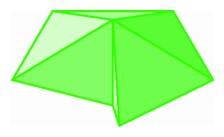The Hypercube Dual or Sixteen-Cell
|
|
Four tetrahedra around an edge in three-space. |
The dihedral angle of a tetrahedron is less than a right angle, so
we can easily fit four tetrahedra around an edge in three-space,
with room to fold up into four-space. There is a regular
polytope that has this configuration of four tetrahedra at each
edge, and to describe its construction we rely on the duality
principle. To construct the dual of a polytope, we choose the
vertex in the center of each three-dimensional face, and we
connect vertices from faces that share a common boundary
polygon. The vertices coming from three-dimensional faces
sharing a vertex determine a three-dimensional polyhedron, the
dual cell of the vertex. The collection of dual cells forms the
dual polytope of the regular polytope.
Like the three-simplex or tetrahedron, the four-simplex is
self-dual. To describe the dual of the hypercube, we choose a
point in the center of each of the eight cubical faces. Around
each of the 16 vertices there are four cubes, each set of four
contributing a tetrahedron to the dual object. We thus obtain a new
regular polytope, the 16-cell, dual to the hypercube, and analogous to
the octahedron, which is dual to the cube in three-space. This
polytope has four tetrahedra around each edge, and it is the third of
the regular polytopes in four-space.
|
|
Projection of the 16-cell into the plane, showing 2 of the 16
three-simplexes. The others are obtained by rotating
the figure by multiples of 45 degrees. |
